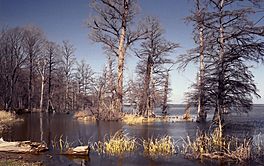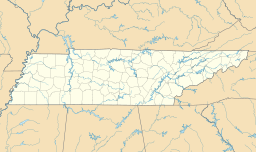Reelfoot Lake facts for kids
Quick facts for kids Reelfoot Lake |
|
|---|---|
 |
|
| Location | Lake / Obion counties, Tennessee, U.S. |
| Coordinates | 36°23′20″N 89°23′20″W / 36.38889°N 89.38889°W |
| Type | sag pond |
| Basin countries | United States |
| Designated: | 1965 |
Reelfoot Lake is a special natural lake in Tennessee, located in Lake and Obion Counties. It's not like most lakes. Much of it is actually a swamp with many bald cypress trees growing right out of the water.
The lake is also famous for its bald eagles. Many bald eagles nest here. The state of Tennessee bought the lake and surrounding land in the early 1900s. This helped create Reelfoot Lake State Park. In 1966, Reelfoot Lake was named a National Natural Landmark. This means it's a very important natural area.
Contents
How Reelfoot Lake Was Formed
Reelfoot Lake was created by powerful natural events. It formed during the 1811–12 New Madrid earthquakes. These earthquakes were very strong. They happened near New Madrid, Missouri.
The Great Earthquakes of 1811-1812
The earthquakes caused the land in northwestern Tennessee to sink. Water from the Mississippi River then flowed into this sunken area. This created the large, shallow lake we see today. People felt these earthquakes far away, even in Canada!
The Mystery of the Name "Reelfoot"
Before the earthquakes, there was a waterway called the Reel Foot River. This river flowed into the Mississippi River. One legend says the lake is named after a Native American chief. He had a deformed foot and walked with a "reeling" motion. So, people called him "Reelfoot."
Another story comes from the Chickasaw tribe. Their legend tells of a prince named Kolopin, or Reelfoot. He had a deformed foot. He wanted to marry a Choctaw princess. But her father said no. Reelfoot disobeyed a warning from the Great Spirit. He kidnapped the princess.
During their wedding, the Great Spirit became angry. He stomped his foot, causing the earth to shake. The Mississippi River overflowed its banks. It flooded Reelfoot's homeland. The water filled the imprint of the Spirit's foot. This formed the beautiful lake. The legend says Reelfoot, his bride, and his people are buried beneath it.
Troubles in the Early 1900s
In the early 1900s, there were big problems around Reelfoot Lake. Many local people made their living from fishing and farming there. But then, a group of investors bought most of the land around the lake. They formed a company called the West Tennessee Land Company. They wanted to control the lake and its fishing rights.
The Night Riders' Actions
This made many local farmers and fishermen very angry. They felt their way of life was being threatened. They formed a group called the Night Riders. They started using violence to resist the company. They attacked and threatened people.
One terrible event happened in October 1908. The Night Riders kidnapped two lawyers working for the land company. One lawyer, Captain Quentin Rankin, was killed. The other, Colonel R. Z. Taylor, was hurt but escaped by swimming across the lake in the dark.
The State Takes Action
The governor of Tennessee, Malcolm Rice Patterson, ordered an investigation. He sent the state militia to stop the violence. Many people were arrested. The governor then declared that Reelfoot Lake belonged to the public.
It took many years for the state to fully gain control of the lake. They built levees (walls to hold back water) from 1917 to 1920. This helped manage the water level. Eventually, the state made Reelfoot Lake a state park. This made sure everyone could use and enjoy it.
Reelfoot Lake Today
Today, Reelfoot Lake covers about 15,000 acres. It is quite shallow, with an average depth of 5.5 feet. Its deepest point is about 18 feet. It is the only large natural lake in Tennessee.
Activities at the Lake
Reelfoot Lake is a popular spot for fun activities. People enjoy boating, fishing, and hunting waterfowl (like ducks). Until 2003, it was the only place in the world where you could legally catch crappie (a type of sunfish) for commercial sale. Restaurants near the lake used to serve it.
Managing Water Levels
Since 1930, a special structure called a spillway has helped control the lake's water levels. It's located where the Running Reelfoot Bayou flows out of the lake. This spillway helps keep the lake healthy for plants and animals. An old spillway was replaced with a new one in 2013.
The town of Samburg, Tennessee, is the only town right on the lake's shores. If you want to learn more about how Reelfoot Lake formed, you can visit Discovery Park of America. It's a museum about 14 miles from the lake. They have an earthquake simulator program that tells the story!
Reelfoot Lake in Movies
Reelfoot Lake has even been a filming location for movies!
- The 1957 drama Raintree County
- The 1967 Oscar-winning In the Heat of the Night
- The 1998 movie U.S. Marshals
Images for kids





